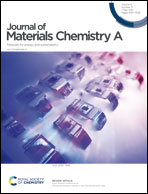Boosting the ultrahigh initial coulombic efficiency of porous carbon anodes for sodium-ion batteries via in situ fabrication of a passivation interface†
Abstract
Porous carbon materials are regarded as one of the most promising candidates for sodium-ion batteries (SIBs) due to their fast sodium storage performance. However, the inadequate initial coulombic efficiency (ICE) resulting from the large specific surface area still hinders the commercialization of porous carbon anodes. Thus, it is important to synthesize porous carbon anodes with high electrochemical performance and improved ICE. Here we prepare a nitrogen and oxygen rich porous carbon material (NOPC) and construct a uniform passivation layer using a sodium carboxymethyl cellulose (CMC) binder on the surface of the NOPC material. The uniform passivation layer effectively deactivates the functional groups and suppresses the decomposition of electrolytes, resulting in an excellent ICE of 90%, which is ultrahigh and competitive among the reported carbon-based anodes in SIBs. Specifically, the as-prepared porous carbon anode delivers a reversible capacity of 191.7 mA h g−1 after 1000 cycles at 10 A g−1 with a capacity retention of 90%. This work suggests a general method to improve the ICE of a carbon material and hopefully facilitates the commercialization process of SIBs.



 Please wait while we load your content...
Please wait while we load your content...